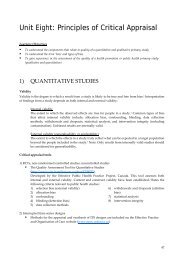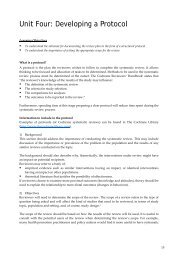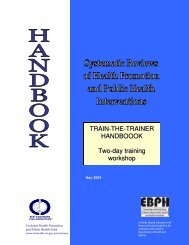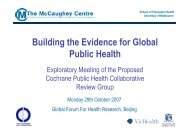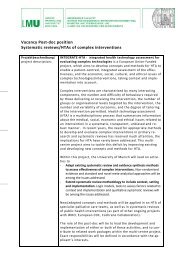Guide for Developing a Cochrane Protocol - Cochrane Public Health ...
Guide for Developing a Cochrane Protocol - Cochrane Public Health ...
Guide for Developing a Cochrane Protocol - Cochrane Public Health ...
Create successful ePaper yourself
Turn your PDF publications into a flip-book with our unique Google optimized e-Paper software.
Was the study adequately protected against contamination?<br />
Score “Yes” if allocation was by community, institution or practice and it is unlikely that the control group received the<br />
intervention. Score “No” if it is likely that the control group received the intervention (e.g. if patients rather than professionals<br />
were randomised). Score “unclear” if professionals were allocated within a clinic or practice and it is possible that communication<br />
between intervention and control professionals could have occurred (e.g. physicians within practices were allocated to<br />
intervention or control)<br />
Was the study free from selective outcome reporting?<br />
Score “Yes” if there is no evidence that outcomes were selectively reported (e.g. all relevant outcomes in the methods section are<br />
reported in the results section). Score “No” if some important outcomes are subsequently omitted from the results. Score<br />
“unclear” if not specified in the paper.<br />
Was the study free from other risks of bias?<br />
Score “Yes” if there is no evidence of other risk of biases<br />
* If some primary outcomes were imbalanced at baseline, assessed blindly or affected by missing data and others were not, each<br />
primary outcome can be scored separately.<br />
**If “UNCLEAR” or “No”, but there is sufficient data in the paper to do an adjusted analysis (e.g. Baseline adjustment analysis or<br />
Intention to treat analysis) the criteria should be re scored to “Yes”.<br />
6.4.2 Risk of bias <strong>for</strong> interrupted time series studies<br />
Seven standard criteria are used <strong>for</strong> all ITS studies. Further in<strong>for</strong>mation can be obtained from the <strong>Cochrane</strong><br />
handbook section on Risk of Bias and from the draft methods paper on risk of bias under the EPOC specific resources<br />
section of the EPOC website.<br />
Note: If the ITS study has ignored secular (trend) changes and per<strong>for</strong>med a simple t-test of the pre versus post<br />
intervention periods without further justification, the study should not be included in the review unless reanalysis is<br />
possible.<br />
Was the intervention independent of other changes?<br />
Score “Yes” if there are compelling arguments that the intervention occurred independently of other changes over time and the<br />
outcome was not influenced by other confounding variables/historic events during study period. If Events/variables identified,<br />
note what they are. Score “NO” if reported that intervention was not independent of other changes in time.<br />
Was the shape of the intervention effect pre-specified?<br />
Score ”Yes” if point of analysis is the point of intervention OR a rational explanation <strong>for</strong> the shape of intervention effect was given<br />
by the author(s). Where appropriate, this should include an explanation if the point of analysis is NOT the point of<br />
intervention;Score “No” if it is clear that the condition above is not met<br />
Was the intervention unlikely to affect data collection?<br />
Score “Yes” if reported that intervention itself was unlikely to affect data collection (<strong>for</strong> example, sources and methods of data<br />
collection were the same be<strong>for</strong>e and after the intervention); Score “No” if the intervention itself was likely to affect data<br />
collection (<strong>for</strong> example, any change in source or method of data collection reported).<br />
Was knowledge of the allocated interventions adequately prevented during the study?***<br />
Score “Yes” if the authors state explicitly that the primary outcome variables were assessed blindly, or the outcomes are<br />
objective, e.g. length of hospital stay. Primary outcomes are those variables that correspond to the primary hypothesis or<br />
question as defined by the authors. Score “No” if the outcomes were not assessed blindly. Score “unclear” if not specified in the<br />
paper.<br />
Were incomplete outcome data adequately addressed?***<br />
Last updated: 24 November 2011 - 27 -



